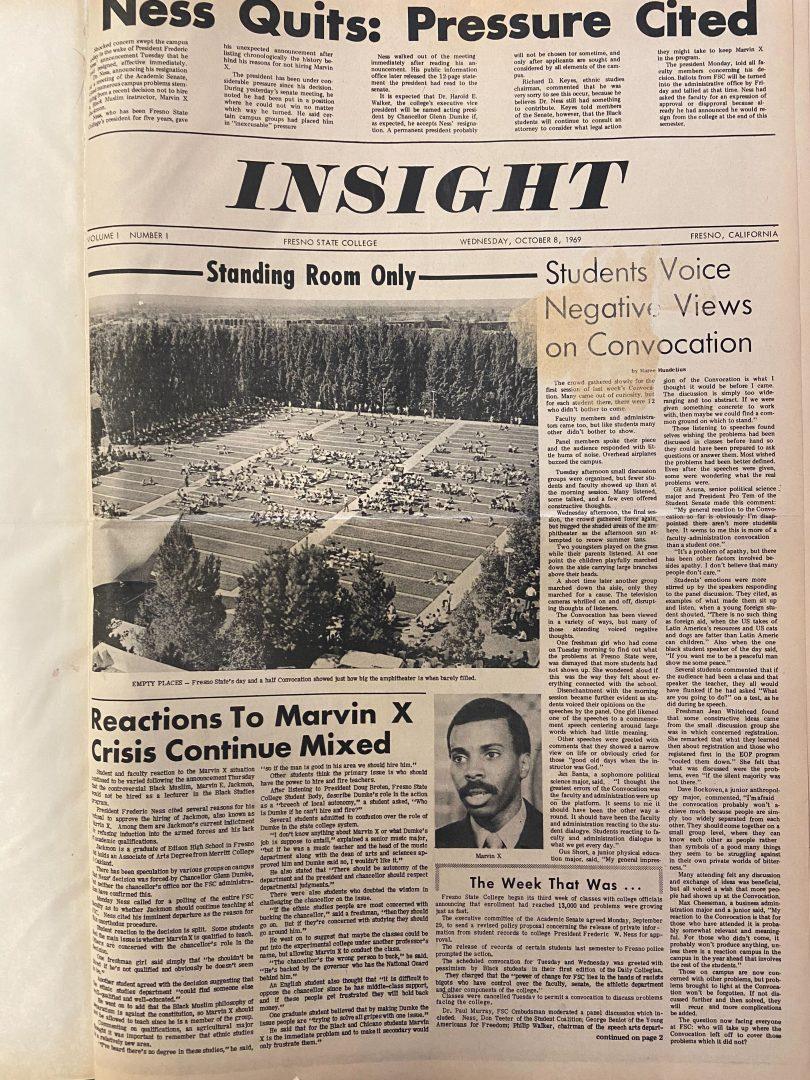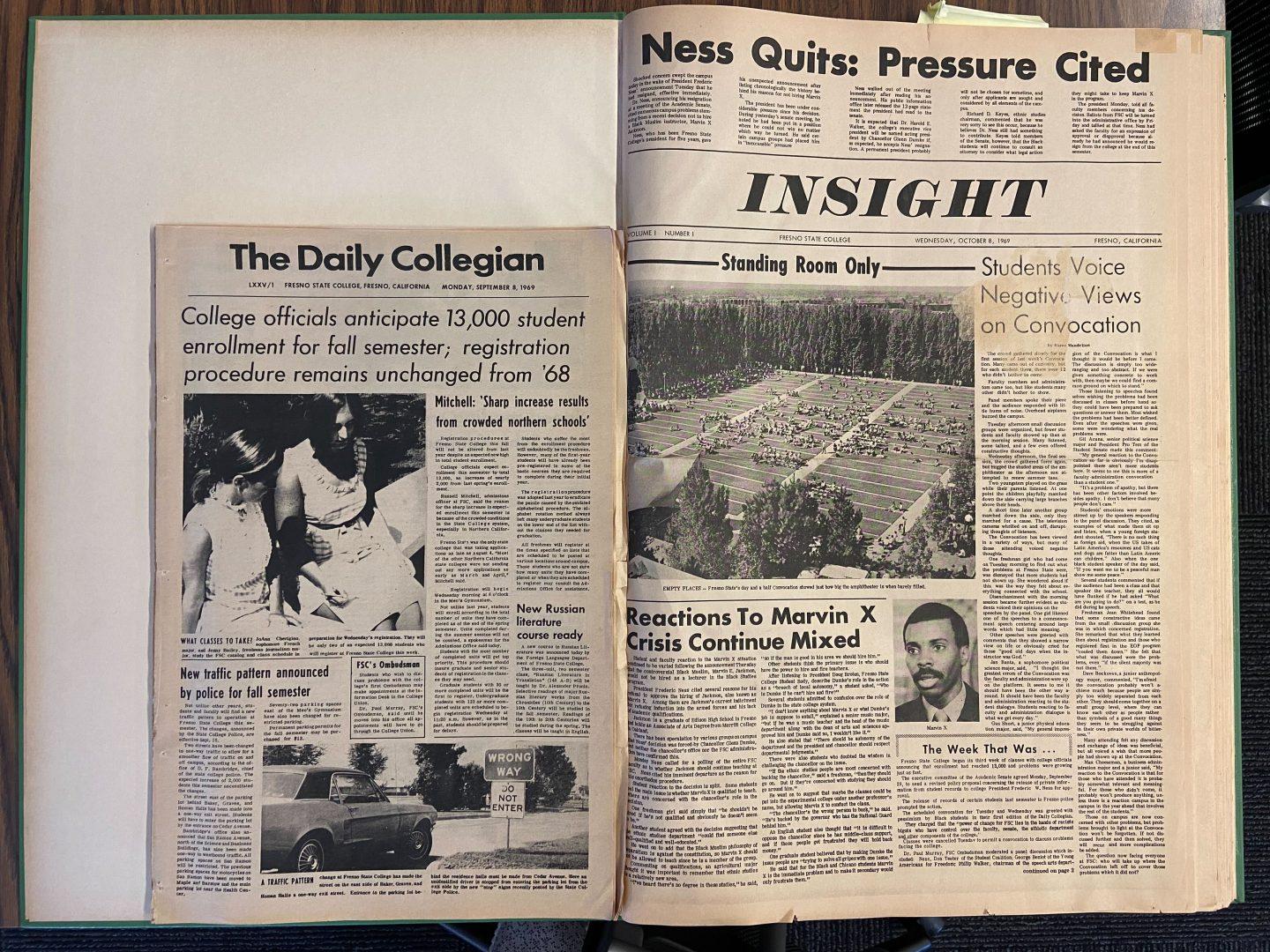In honor of The Collegian’s 100th anniversary, the newspaper looks back at one of the most historical moments in the publication’s history: the day The Collegian split from the Journalism Department in 1969.
Former Collegian and Insight staff reporter Jan Yanehiro described the era as a sudden moment of change, which she describes as the “perfect storm of events” coming together on campus
Introduction to Campus Unrest (1967-1969)
In 1969, Fresno State was experiencing mass demonstrations on the university campus in what would be known as “campus unrest,” which swept the nation during the late ‘60s to early ‘70s.
The main issue causing that unrest ranged from things such as tuition hikes under former Gov. Ronald Reagan to the anti-ROTC protests taking place to the protest for academic freedom.
“The raging of the Vietnam War, the protesters; women are burning their bras and guys are burning their [draft] cards… It was really the movement of free-thinking and independence,” Yanehiro said.
Many of the demonstrations took place in what is still used in 2022 as the Free Speech Area, located in the center of the campus. Those demonstrations often drew hundreds of spectators from the university as well as members of the local community.

The anti-ROTC protest sought the removal from campus of the 035 detachment of the Air Force Reserves Officer Training Corps, which had been established in 1948.
The protest for academic freedom was spurred by former Fresno State president Fredric Ness refusing to hire English professor Robert Mezey due to comments Mezey made during the Pot Parley Forum in 1967.
While Mezey did not outright endorse the use of marijuana, he did claim that usage of the drug lacked the negative health effects of other hard narcotics it was being compared with.
Mezey’s comments were seen by the wider community, and some faculty members, as unprofessional and dangerous as a teacher due to his close proximity to college students, who were viewed at the time as influential children.
The Approval of the Minority Editions
The Daily Collegian, as it was known at the time, soon found itself at the center of controversy following the approval of minority editions of the paper
On May 2, 1969, the Board of Publications approved in a 5 – 2 vote the creation of two minority editions of The Daily Collegian. Both still exist today: Uhuru and La Voz de Aztlan.
The minority editions were split between the African-American and Latinx students on campus, alternating each week in a four-page publication. The controversy surrounding the approval of the minority editions concerned the editorial policy of the editions.
Alongside the creation of the minority editions, the minority students on campus would have full editorial control over the weekly editions. It was assumed this would be used to expand minority student opinions on campus.
Ambitions of the Minority Supplements
John Ramierez, the first Latino editor of the Latinx supplement, argued that the missions of the supplements were to represent minority views in an unabridged manner, something they were unable to do prior.
“There is no other way because minority views are not respected… We can’t be put within the paper. We feel that we should be heard as a voice independent of The Collegian,” said Ramierez at the time in an interview with The Collegian.
The former Black Student Union representative for Fresno State, Osby Davis, noted that the need for separate publications arose due to minority groups being separated from society, thus so did the supplements.
“We aren’t on a level of understanding where we can work together. We cannot work together until we can understand each other . . . We have to inform you what is happening today,” said Davis in an interview with The Collegian at the time.
Both Davis and Ramierez hoped they could avoid potential campus unrest, particularly in light of the San Francisco State College demonstration that very year, in which students took to the streets protesting the university and the local ROTC presence on campus.
Criticism of the Special Editions
Criticism of the special editions quickly arose across the university from members of the faculty and Student Senate due to the broad implications a minority edition of The Daily Collegian might have.
During the 1968 fall and spring semesters, a total of 11,141 students were attending Fresno State College, less than half of today’s campus population. In 2022, over 25,000 students were in attendance.
At the time, Fresno State was considered a majority-white university, with nearly 80% of the campus population identifying as caucasian. The largest minority groups at the time, African-American and Latinx students, constituted 8.9% of the student population. Asian Americans and Indigenous Americans students accounted for 5.7% of the student population.
Fresno State was seen as a university that served the needs of the community of the San Joaquin Valley, which was predominantly conservative, according to Yanehiro.
The senator of the school of business at the time, Dennis Reese, argued that the creation of the supplements would provide unequal coverage and treatment of groups on campus, who would soon want a special edition of their own.
“If the Blacks and Chicanos are given an issue of the paper, then the Bulldog party and the Greeks will want an issue,” Reese said at the time in an interview with The Collegian.
Former senator of publications, Gary Daloyan, compared the Board of Publication’s decision to a violation of the principles of a free press, hinting that the journalism department would step away from The Collegian should the Student Senate approve of the minority additions.
“If the Student Senate fails to overrule the action by the Board of Publications at its Wednesday meeting, the department of journalism will strongly consider divorcing itself from The Daily Collegian as it now exists,” Daloyan said.
The senate ultimately approved the special editions of The Daily Collegian on May 8, 1969, following two hours of deliberation that resulted in 17 voting yes, 8 voting no and 1 abstain vote.
The Journalism Department Divorce
Daloyan’s warning became reality on May 14, 1969, when The Daily Collegian announced its split from the Journalism Department via an open letter published on the front page of the newspaper.

Chairman of the Journalism Department at the time, Paul V. Sheehan, announced that the department unanimously voted to split from The Daily Collegian on the grounds of its own professional ideals.
Sheehan acknowledged the decision of the student senate, but claimed he could not support the decision, as he believed it would harm the reputation and integrity of The Daily Collegian should specific groups get a special voice.
“A good newspaper will rarely win a popularity contest. It does not exist for that purpose. It frequently is the target, consequently, of those who disagree with or dislike its editorial policies,” Sheehan said in a letter published in The Collegian.
“Unless it can withstand efforts to curtail its independence, it soon finds that it is the prisoner of whatever political pressure group happens to have the most influence at any given time. When that happens, its value as a newspaper is gone.”
Sheehan revealed that the Journalism Department would consolidate its focus on the creation of a new laboratory newspaper which would see its first publication on Oct. 8, 1969, under the name Insight.
The Creation of The Insight
Yanehiro recalled that the staff of The Daily Collegian was given a choice to either join the newly developed Insight or continue working for The Daily Collegian following the announcement.
Yanehiro and much of the staff would either completely transition or work for both The Daily Collegian and The Insight during the following semester with the first publication of the new paper on Oct. 8, 1969.
The Insight aimed to provide a clean and sophisticated look compared to The Daily Collegian, adopting longer format articles.
To accommodate longer format writing, The Insight increased in paper size, which dwarfed The Daily Collegian by several inches in both width and height.
“I remember we wanted Insight to be clean, meaning, you know, looking sharp, nothing messy… We wanted big, so you can see how big it was, and we wanted it clean,” Yanehiro said.
The first issue of The Insight would be an eventful one, as the paper covered the resignation of President Ness following the Marvin X case.

Marvin X was a Black, Muslim professor who applied to the ethnic studies department to become a part-time professor to teach his unique brand of Black education on campus.
Ness refused to hire Marvin X after claiming he received an incomplete application. However, when Ness published an internal poll after the incident that featured unfavorable sentiments toward him by members of the community and faculty, he resigned.
The Insight went on to run for 28 years, with its last publication on May 13, 1998, as the newspaper would be consolidated with The Daily Collegian for the 1998 fall semester.
The Daily Collegian would also once again return to what is now called the Media, Communications and Journalism Department, ending its 28-year-long run separate from the journalism department.
CORRECTION: March 11, 2022
An earlier version of this article misspelled the name of the former head of the Journalism Department. It is Paul V. Sheehan, not Paul V. Shoeman. The Collegian regrets this error.





